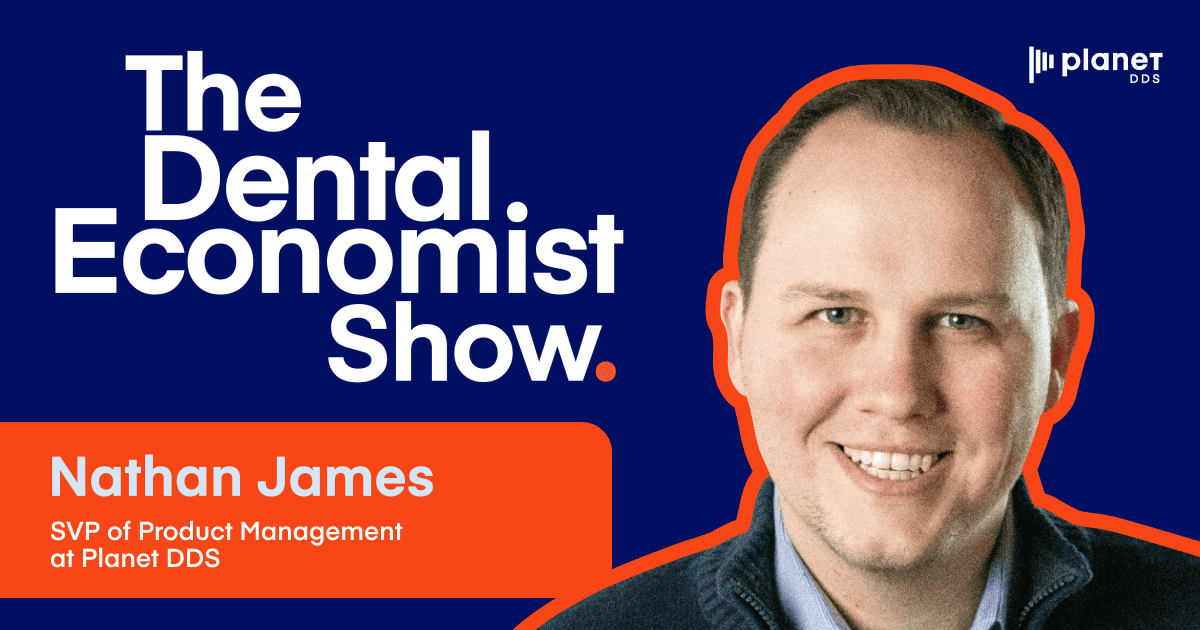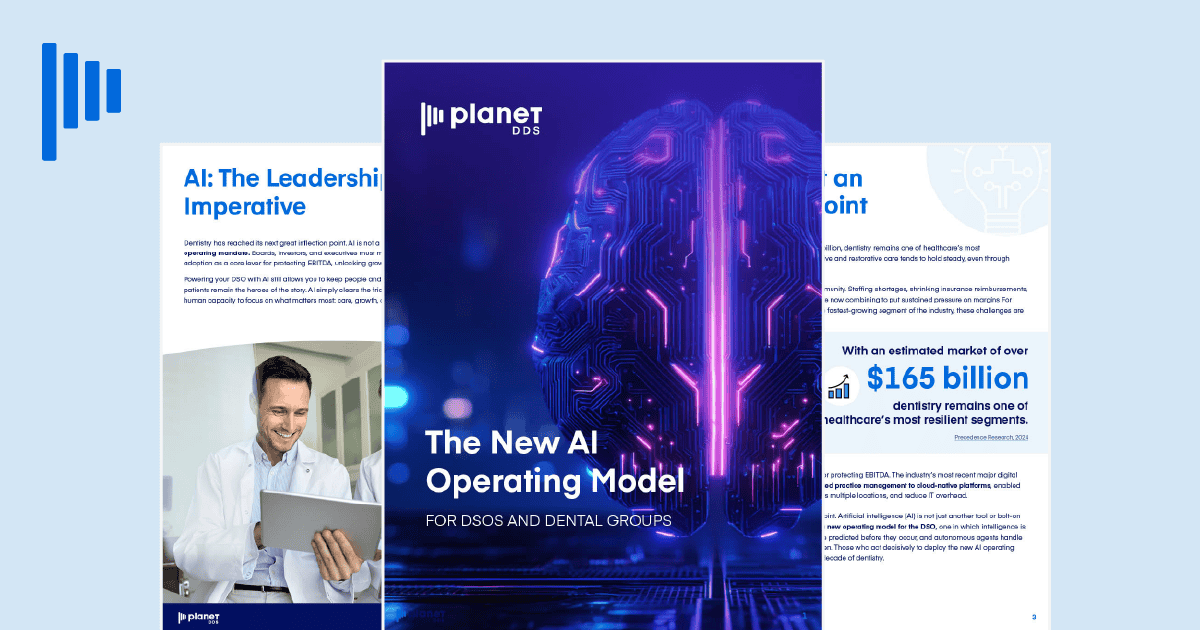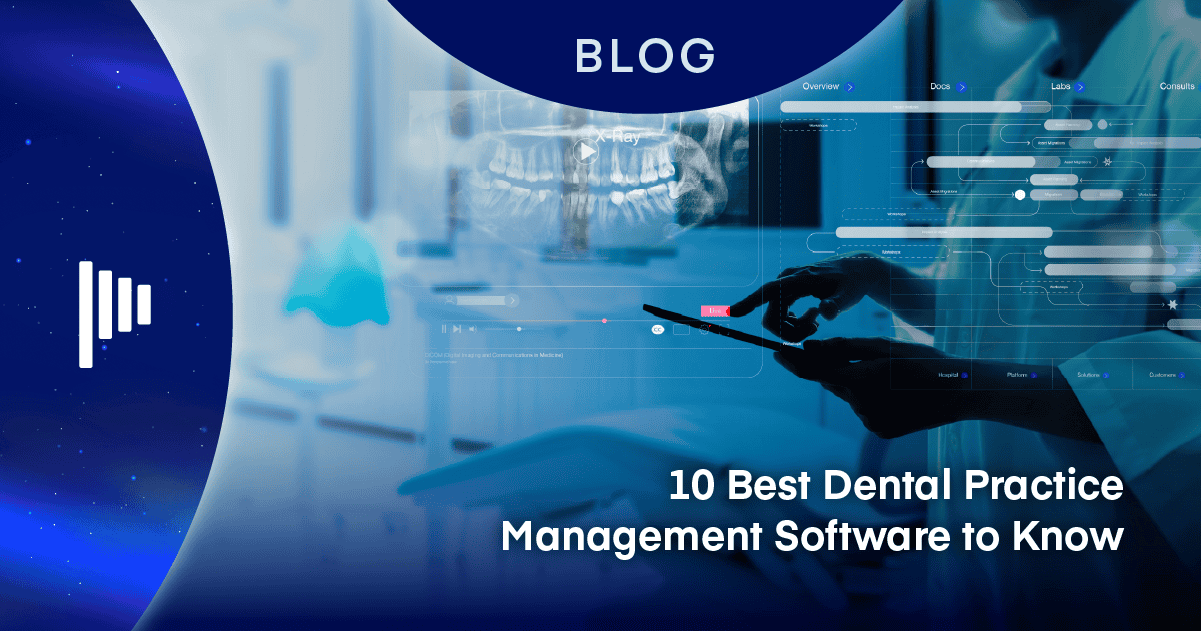Nathan James on Taking the Leap, Trusting Dental Tech, and Embracing the Future

Dental’s in-flight mode when it comes to AI and it needs to step into embrace mode. In the latest episode of The Dental Economist Show, we explore why and how. Tune in as host CRO Mike Huffaker sits down with Nathan James, senior vice president and global head of product design at Planet DDS, to explore the intersection of AI innovation, product strategy, and dental practice management.
What you’ll learn:
- How to distinguish between exploration and implementation when adopting AI tools
- Why dental technology lags behind other industries and why that’s actually an opportunity
- The critical difference between LLMs, generative AI, and AI agents and why it matters for your practice
- How to vet AI vendors before committing your practice’s data and dollars
- The scheduling agent framework that could revolutionize your practice’s revenue cycle
- Why revenue cycle management (RCM) is the highest-leverage opportunity for DSO margin expansion in the next two years
- How to build customer-centric product strategy that actually moves the needle
- The product manager’s role as organizational connective tissue in any practice or business
This episode is sure to inject some much-needed curiosity and vigor into your approach to dental tech.
Episode Highlights
In this episode, Mike Huffaker and Nathan James explore a game-changing framework on making AI adoption successful. Here are some highlights from the show:
AI adoption in dental tech: Explore first, scale later
Nathan James emphasizes that adopting AI tools requires two distinct phases: discovery and exploration first, then adoption and scale, and rushing between them is where most practices stumble. During the exploration phase, you should experiment with everything available (ChatGPT, Claude, Copilot, Perplexity) to understand what’s possible without committing long-term contracts.
The critical mistake dental leaders make is signing three-year deals with exciting new tools before validating whether they actually solve your practice’s pain points or integrate with your existing tech stack. Start by identifying early wins through experimentation, then only after proving return on investment (ROI) should you begin iterative rollouts into your core systems.
The pros of purpose-built AI agents
While commercial LLMs like ChatGPT can hallucinate because they’re trained on massive, unfiltered datasets, AI agents built for dental practices work entirely differently. They access only your practice’s specific patient data and business rules through APIs. James’s scheduling agent example illustrates this perfectly: You tell it your constraints (hygiene appointments only on Mondays, crowns clustered Thursday afternoons), and it analyzes your actual patient database, not the internet, to rank and contact the most likely-to-show patients via voice, text, and email.
This data partitioning approach delivers accuracy because the system has zero access to irrelevant information; it’s solving one specific problem with one specific dataset.
How to vet AI vendors for security
Just as hackers once exploited SQL injection vulnerabilities in databases, they can now manipulate AI agents through “prompt injection,” cleverly phrased responses designed to trick the system into revealing patient PHI or violating HIPAA compliance. James stresses that legitimate AI vendors build multiple layers of data partitioning: The agent never has access to sensitive patient details until the caller proves their identity through configurable verification (date of birth, name, insurance number).
When evaluating an AI company, don’t just ask “Is this cool?” Investigate their management team, financial backing, and ten-year burn rate like you would a practice acquisition.
Customer centricity with advisory boards of “mavens”
James’s approach to product strategy is radically customer-centric: Planet DDS launched seven customer advisory boards populated by “mavens,” early adopters who evangelize solutions to peers, and meeting quarterly to review roadmaps and monthly for iterative progress on features. The genius is that instead of product teams guessing which feature matters most (Feature A versus Feature B), they ask the customers directly: “Will this actually deliver the value we think it will, or are we solving the wrong problem?” These boards surface the consistent pain point across all DSOs—revenue squeeze and EBITDA pressure—which becomes the North Star for prioritization.
By embedding customers into the product development process rather than just collecting surveys, you gain business context that no internal team can replicate, ensuring every release directly addresses the real financial or operational pain rather than shiny features nobody needs.
Unpacking the prioritization framework
When James evaluates competing features or initiatives, the deciding factor is always the same: Which one saves clinicians or RCM staff the most time? This ruthless impact-per-hour-saved lens cuts through nice-to-have ideas and focuses engineering effort on margin-expanding wins that directly reduce headcount costs or revenue leakage. He’s discovered that even the most efficient DSOs spend one RCM FTE for every $12 million in processed revenue—still expensive—and Planet DDS’s vision is to get that to one FTE per $15 to 20 million through RCM automation inspired by the payments industry.
By always asking “How much time does this save?” instead of “How innovative is this?” you stay aligned with DSO profitability rather than chasing buzzwords, and your team understands the business logic behind every sprint.
Why product leaders act as the connective tissue
James believes product managers are “connective tissue” across organizations, and that means attending real sales conversations, implementation calls, and account reviews—not via summary email, but in real-time. He even required his entire product team to read sales books so they understand pipeline, lead qualification, and champion dynamics, ensuring product decisions reflect what customers actually need versus what internal teams assume they need.
When a sales rep struggles during a demo or a customer expresses frustration, product managers sitting in that conversation gain context no survey can provide and spot the next priority before it becomes a churn risk. This philosophy breaks down the classic product-sales wall that plagues growing organizations, ensuring your team ships solutions to the exact problems your market is experiencing today, not yesterday’s assumptions.
The Dental Economist Show
Don’t miss insightful conversations with industry experts on the latest trends and top strategies to grow your DSO or dental group. Tune in to The Dental Economist Show each week as we meet at the intersection of profit and purpose.
List to the full podcast:



